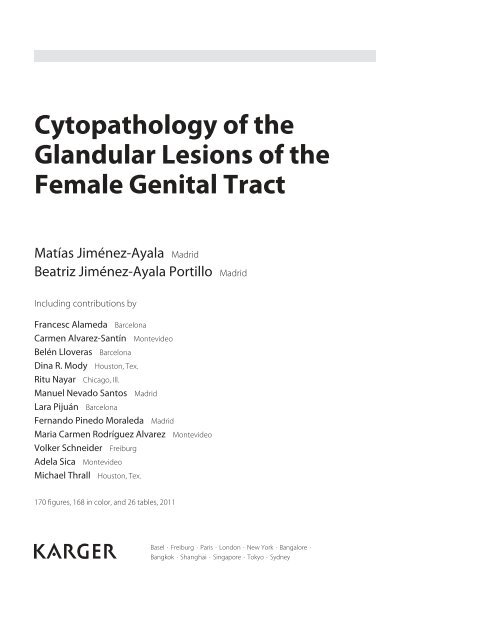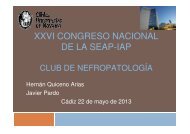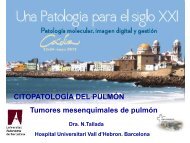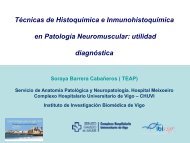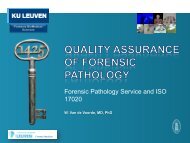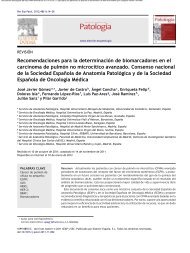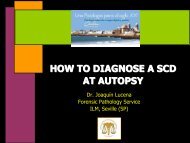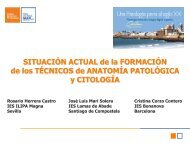Cytopathology of the Glandular Lesions of the Female Genital Tract
Cytopathology of the Glandular Lesions of the Female Genital Tract
Cytopathology of the Glandular Lesions of the Female Genital Tract
Create successful ePaper yourself
Turn your PDF publications into a flip-book with our unique Google optimized e-Paper software.
<strong>Cytopathology</strong> <strong>of</strong> <strong>the</strong><strong>Glandular</strong> <strong>Lesions</strong> <strong>of</strong> <strong>the</strong><strong>Female</strong> <strong>Genital</strong> <strong>Tract</strong>Matías Jiménez-Ayala MadridBeatriz Jiménez-Ayala Portillo MadridIncluding contributions byFrancesc Alameda BarcelonaCarmen Alvarez-Santín MontevideoBelén Lloveras BarcelonaDina R. Mody Houston, Tex.Ritu Nayar Chicago, Ill.Manuel Nevado Santos MadridLara Pijuán BarcelonaFernando Pinedo Moraleda MadridMaria Carmen Rodríguez Alvarez MontevideoVolker Schneider FreiburgAdela Sica MontevideoMichael Thrall Houston, Tex.170 figures, 168 in color, and 26 tables, 2011Basel · Freiburg · Paris · London · New York · Bangalore ·Bangkok · Shanghai · Singapore · Tokyo · Sydney
Monographs in Clinical CytologyDr. Matías Jiménez-AyalaInstituto Jiménez-AyalaHermosilla 126E-28028 Madrid (Spain)E-Mail matiasjimenezayala@hotmail.comDr. Beatriz Jiménez-Ayala PortilloInstituto Jiménez-AyalaHermosilla 126E-28028 Madrid (Spain)E-Mail beatriz@institutojimenezayala.comLibrary <strong>of</strong> Congress Cataloging-in-Publication DataThis publication was sponsered byJiménez-Ayala, Matías.<strong>Cytopathology</strong> <strong>of</strong> <strong>the</strong> glandular lesions <strong>of</strong> <strong>the</strong> female genital tract /Matías Jimenéz-Ayala, Beatriz Jimenéz-Ayala Portillo ; includingcontributions by Frances Alameda Barcelona ... [et al.].p. ; cm. -- (Monographs in clinical cytology, ISSN 0077-0809 ; v.20)Includes bibliographical references and index.ISBN 978-3-8055-9464-6 (hard cover : alk. paper) -- ISBN 978-3-8055-9465-3(e-ISBN)1. Generative organs, <strong>Female</strong>--<strong>Cytopathology</strong>. I. Jiménez-Ayala Portillo,Beatriz. II. Title. III. Series: Monographs in clinical cytology ; v. 20.0077-0809[DNLM: 1. <strong>Genital</strong> Neoplasms, <strong>Female</strong>--diagnosis. 2. <strong>Genital</strong> Neoplasms,<strong>Female</strong>--pathology. 3. Cytodiagnosis--methods. 4. Neoplasms, <strong>Glandular</strong> andEpi<strong>the</strong>lial--diagnosis. 5. Neoplasms, <strong>Glandular</strong> and Epi<strong>the</strong>lial--pathology.W1 MO567KF v. 20 2011 / WP 145]RG107. 5. C95. J56 2011618.1--dc222010041126Bibliographic Indices. This publication is listed in bibliographic services, including Current Contents®.Disclaimer. The statements, opinions and data contained in this publication are solely those <strong>of</strong> <strong>the</strong> individual authors and contributors and not <strong>of</strong> <strong>the</strong> publisher and <strong>the</strong> editor(s).The appearance <strong>of</strong> advertisements in <strong>the</strong> book is not a warranty, endorsement, or approval <strong>of</strong> <strong>the</strong> products or services advertised or <strong>of</strong> <strong>the</strong>ir effectiveness, quality or safety. Thepublisher and <strong>the</strong> editor(s) disclaim responsibility for any injury to persons or property resulting from any ideas, methods, instructions or products referred to in <strong>the</strong> content oradvertisements.Drug Dosage. The authors and <strong>the</strong> publisher have exerted every effort to ensure that drug selection and dosage set forth in this text are in accord with current recommendationsand practice at <strong>the</strong> time <strong>of</strong> publication. However, in view <strong>of</strong> ongoing research, changes in government regulations, and <strong>the</strong> constant flow <strong>of</strong> information relating to drug <strong>the</strong>rapyand drug reactions, <strong>the</strong> reader is urged to check <strong>the</strong> package insert for each drug for any change in indications and dosage and for added warnings and precautions. This isparticularly important when <strong>the</strong> recommended agent is a new and/or infrequently employed drug.All rights reserved. No part <strong>of</strong> this publication may be translated into o<strong>the</strong>r languages, reproduced or utilized in any form or by any means electronic or mechanical, includingphotocopying, recording, microcopying, or by any information storage and retrieval system, without permission in writing from <strong>the</strong> publisher.© Copyright 2011 by S. Karger AG, P.O. Box, CH–4009 Basel (Switzerland)www.karger.comPrinted in Switzerland on acid-free and non-aging paper (ISO 9706) by Reinhardt Druck, BaselISSN 0077–0809ISBN 978–3–8055–9464–6e-ISBN 978–3–8055–9465–3
To Sara, for her family ‘sacrifices’ during her first 2 years <strong>of</strong> life andin <strong>the</strong> hope she will be <strong>the</strong> third step in our cytopathology saga.
ContentsXIIIXIVXVXVIPrefaceForewordList <strong>of</strong> AbbreviationsList <strong>of</strong> AuthorsChapter 1Cytopathological Techniques for <strong>the</strong> Diagnosis <strong>of</strong> <strong>Glandular</strong> <strong>Lesions</strong> <strong>of</strong> <strong>the</strong> <strong>Genital</strong> <strong>Tract</strong>1 1.1. Introduction1 1.2. Fixation2 1.3. Staining3 1.4. Special Techniques4 ReferencesChapter 22001 Be<strong>the</strong>sda System Classification <strong>of</strong> <strong>Glandular</strong> <strong>Lesions</strong> on Cervical Cytology5 2.1. Introduction6 2.2. <strong>Glandular</strong> Epi<strong>the</strong>lial Cell Abnormalities6 2.2.1. Atypical <strong>Glandular</strong> Cells6 2.2.2. Atypical Endocervical Cells7 2.2.3. Atypical Endometrial Cells8 2.3. Endocervical Adenocarcinoma in situ9 2.4. Adenocarcinoma12 2.5. O<strong>the</strong>r12 2.5.1. Endometrial Cells in Women ≥40 Years <strong>of</strong> Age13 2.6. Impact <strong>of</strong> <strong>the</strong> 2001 Be<strong>the</strong>sda System13 2.7. Management14 ReferencesChapter 3<strong>Cytopathology</strong> <strong>of</strong> <strong>the</strong> Benign <strong>Glandular</strong> <strong>Lesions</strong> <strong>of</strong> <strong>the</strong> Cervix and <strong>Glandular</strong> <strong>Cytopathology</strong> <strong>of</strong> <strong>the</strong> Vagina15 3.1. <strong>Cytopathology</strong> <strong>of</strong> Benign <strong>Glandular</strong> <strong>Lesions</strong> <strong>of</strong> <strong>the</strong> Cervix15 3.1.1. Benign tumorsVII
15 3.1.1.1. Endocervical Polyp15 3.1.1.2. Müllerian Papilloma16 3.1.2. O<strong>the</strong>r Non-Tumoral <strong>Lesions</strong>16 3.1.2.1. Tubal Metaplasia17 3.1.2.2. Microglandular Hyperplasia18 3.1.2.3. Cells <strong>of</strong> <strong>the</strong> Lower Uterine Segment19 3.1.2.4. Endometriosis19 3.1.2.5. Arias-Stella Reaction20 3.2. <strong>Glandular</strong> <strong>Cytopathology</strong> <strong>of</strong> <strong>the</strong> Vagina20 3.2.1. Tumoral <strong>Lesions</strong>20 3.2.1.1. Benign Tumoral <strong>Lesions</strong>: Adenomas20 3.2.1.2. Malignant Tumoral <strong>Lesions</strong>: Adenocarcinomas20 3.2.1.2.1. Clear Cell Adenocarcinoma21 3.2.1.2.2. Endometrioid Adenocarcinoma22 3.2.1.2.3. Mucinous Adenocarcinoma22 3.2.1.2.4. Mesonephric Adenocarcinoma22 3.2.2. Non-Tumoral <strong>Lesions</strong>22 3.2.2.1. Adenosis23 3.2.2.2. Fistulous <strong>Tract</strong>s23 3.2.2.3. Tubal Prolapse24 3.2.2.4. Post-Hysterectomy <strong>Glandular</strong> Cells24 ReferencesChapter 4<strong>Cytopathology</strong> <strong>of</strong> Adenocarcinoma in situ <strong>of</strong> <strong>the</strong> Endocervix and Its Differential Diagnosis26 4.1. Introduction26 4.2. Normal Endocervical Mucosa27 4.3. Benign and Reactive Changes27 4.4. Adenocarcinoma in situ30 4.5. Clinical Management <strong>of</strong> AIS31 4.6. Microinvasive Adenocarcinoma31 4.7. CIN 3 Mimics AIS31 4.8. Pregnancy Changes31 4.9. The Vaginal Cuff32 ReferencesChapter 5<strong>Cytopathology</strong> <strong>of</strong> <strong>the</strong> Malignant Invasive <strong>Lesions</strong> <strong>of</strong> <strong>the</strong> Endocervix34 5.1. Introduction34 5.2. Types <strong>of</strong> Malignant Invasive <strong>Lesions</strong> <strong>of</strong> <strong>the</strong> Endocervix34 5.3. Invasive Endocervical Adenocarcinoma34 5.3.1. Early Invasive Adenocarcinoma35 5.3.2. Mucinous Adenocarcinoma36 5.3.2.1. Endocervical Type Adenocarcinoma <strong>of</strong> <strong>the</strong> Endocervix38 5.3.2.2. Intestinal Variant38 5.3.2.3. Signet-Ring Cell Variant38 5.3.2.4. Minimal Deviation Variant39 5.3.3. Villoglandular Adenocarcinoma40 5.3.4. Endometrioid Adenocarcinoma <strong>of</strong> <strong>the</strong> Cervix40 5.3.5. Clear-Cell Adenocarcinoma41 5.3.6. Serous AdenocarcinomaVIIIContents
41 5.4. Uncommon Carcinomas <strong>of</strong> <strong>the</strong> Cervix41 5.4.1. Adenosquamous Carcinoma <strong>of</strong> <strong>the</strong> Cervix41 5.4.2. Glassy Cell Carcinoma Variant42 5.4.3. Adenoid Cystic Carcinoma <strong>of</strong> <strong>the</strong> Cervix43 5.4.4. Adenoid Basal Carcinoma <strong>of</strong> <strong>the</strong> Cervix43 5.4.5. Neuroendocrine Tumors43 5.5. Tumors Metastatic to <strong>the</strong> Cervix44 ReferencesChapter 6Endometrial Hyperplasias45 6.1. Introduction45 6.2. Clinical Features45 6.3. Pathophysiology46 6.4. Histopathology: WHO Classification47 6.5. Multicentric European Study on Endometrial Hyperplasia47 6.6. Diagnosis <strong>of</strong> Endometrial Hyperplasia47 6.7. Differential Diagnosis <strong>of</strong> Endometrial Hyperplasias48 6.8. Endometrial Intraepi<strong>the</strong>lial Neoplasia48 6.8.1. Concept48 6.8.2. Clinical Features48 6.8.3. Diagnosis48 6.8.4. Management <strong>of</strong> EIN48 6.9. Current Status <strong>of</strong> <strong>Cytopathology</strong> <strong>of</strong> Endometrial Hyperplasias49 6.10. Practical Considerations49 6.11. <strong>Cytopathology</strong> <strong>of</strong> Endometrial Hyperplasias: The Jiménez-Ayala Classification49 6.11.1. Endometrial Hyperplasia50 6.11.2. Endometrioid Neoplasia51 ReferencesChapter 7Endometrial Adenocarcinoma: Current Status and Future <strong>of</strong> Prevention andEarly Diagnosis52 7.1. Introduction52 7.2. Current Status <strong>of</strong> <strong>the</strong> Prevention and Early Diagnosis <strong>of</strong> Endometrial Adenocarcinoma52 7.2.1. Increasing Incidence52 7.2.2. Pathogenesis53 7.2.3. High-Risk Population53 7.2.4. High-Risk Factors53 7.2.5. Diagnostic Methods for Endometrial Screening Program54 7.2.5.1. Techniques <strong>of</strong> Endometrial Cytology54 7.2.5.2. Histological Techniques55 7.2.5.3. New Gynecological Methods55 7.2.6. Histopathology <strong>of</strong> EmA: Grading55 7.2.7. Cytopathological Grading <strong>of</strong> EmA56 7.2.7.1. Low-Grade Adenocarcinoma (Well Differentiated)56 7.2.7.2. High-Grade Adenocarcinoma (Poorly Differentiated)57 7.2.8. Liquid-Based Preparation57 7.3. Future <strong>of</strong> Prevention and Early Diagnosis57 7.3.1. Challenges in Detection <strong>of</strong> Endometrial Malignant <strong>Lesions</strong>57 7.3.1.1. Assessment <strong>of</strong> High-Risk PopulationContentsIX
86 9.7. Final Remarks86 ReferencesChapter 10<strong>Glandular</strong> <strong>Lesions</strong> <strong>of</strong> <strong>the</strong> Fallopian Tube87 10.1. Histology <strong>of</strong> <strong>the</strong> Fallopian Tube87 10.2. Benign Fallopian Tube <strong>Lesions</strong>87 10.3. Tumors <strong>of</strong> <strong>the</strong> Fallopian Tube88 10.3.1. Benign Epi<strong>the</strong>lial Tumors88 10.3.2. Malignant Epi<strong>the</strong>lial Tumors89 10.3.3. Borderline Epi<strong>the</strong>lial Tumors89 10.3.4. Carcinoma in situ89 10.4. Diagnosis <strong>of</strong> Tubal Carcinoma90 10.4.1. Cytology90 10.4.2. Cytological Features91 10.5. Differential Diagnosis91 ReferencesChapter 11Metastatic <strong>Glandular</strong> <strong>Lesions</strong>92 11.1. Introduction92 11.2. Metastases to <strong>the</strong> <strong>Genital</strong> <strong>Tract</strong>92 11.2.1. Metastases to <strong>the</strong> Vulva93 11.2.2. Metastases to <strong>the</strong> Vagina94 11.2.3. Metastases to <strong>the</strong> Cervix95 11.2.4. Metastases to <strong>the</strong> Endometrium95 11.2.5. Metastases to <strong>the</strong> Ovary96 11.3. Origin <strong>of</strong> Metastases96 11.3.1. Intragenital Metastases96 11.3.1.1. Metastases <strong>of</strong> Ovarian Origin97 11.3.1.2. Metastases <strong>of</strong> Endometrial Origin97 11.3.2. Extragenital Metastases97 11.3.2.1. Breast carcinoma97 11.3.2.2. Gastrointestinal <strong>Tract</strong>98 11.4. Clues for <strong>the</strong> Diagnosis <strong>of</strong> Metastatic Carcinomas in Cervicovaginal Smear99 ReferencesChapter 12Ancillary Techniques for <strong>the</strong> Diagnosis <strong>of</strong> <strong>Glandular</strong> <strong>Lesions</strong> <strong>of</strong> <strong>the</strong> <strong>Female</strong> <strong>Genital</strong> <strong>Tract</strong>101 12.1. Introduction102 12.2. HPV Probe102 12.2.1. Hybrid Capture II102 12.2.2. PCR103 12.3. Immunohistochemical Techniques for p16105 12.4. O<strong>the</strong>r Techniques106 12.5. Conclusion106 References107 IndexContentsXI
PrefaceFollowing our first publication in <strong>the</strong> Karger seriesMonographs in Clinical Cytology (vol. 17), which wasdevoted to endometrial adenocarcinoma, we have spent <strong>the</strong>last 2 years to preparing this second volume, <strong>Glandular</strong><strong>Lesions</strong> <strong>of</strong> <strong>the</strong> <strong>Female</strong> <strong>Genital</strong> <strong>Tract</strong>. We have been supportedin this by series editor Dr. Svante Orell and KargerPublishers. The subject is an area in which we have wideexperience and, on this occasion, we have been honored towelcome contributions from 12 international experts in <strong>the</strong>cytopathology <strong>of</strong> glandular lesions. Their writings cover <strong>the</strong>wide spectrum <strong>of</strong> this challenging subject.<strong>Genital</strong> glandular lesions, both benign and malignant,are an attractive area <strong>of</strong> cytopathology. Malignant lesions <strong>of</strong><strong>the</strong> endocervix and endometrium are becoming more commonall <strong>the</strong> world, compared to squamous cell carcinoma.In this volume we present discussions <strong>of</strong> in situ and invasiveendocervical adenocarcinoma, endometrial adenocarcinomaand endometrial hyperplasias.Ovarian lesions focusing data obtained from intraoperativestudies are considered. O<strong>the</strong>r areas <strong>of</strong> <strong>the</strong> genital tract,such as <strong>the</strong> vulva and <strong>the</strong> fallopian tube, which are less commonand thus have seen fewer publications, are also presented.The impact <strong>of</strong> <strong>the</strong> Be<strong>the</strong>sda System and basic andancillary techniques in <strong>the</strong> study <strong>of</strong> glandular lesions completeour monograph.We hope that this monograph will be useful tocytopathologists, pathologists, cytotechnologists and to students<strong>of</strong> <strong>the</strong>se specialities, as it deals with <strong>the</strong> most commonareas <strong>of</strong> <strong>the</strong>ir daily work.AcknowledgementsOur gratitude goes to Dr. Svante Orell and to Mr. Thomas Noldfor <strong>the</strong>ir stimulating discussions and help in <strong>the</strong> preparation <strong>of</strong>this book. Thanks also to <strong>the</strong> contributors and to <strong>the</strong> staff <strong>of</strong> <strong>the</strong>Instituto Jiménez-Ayala, with special mention to PalomaFernandez Rueda for her dedicated and efficient secretarial work,and to senior cytotechnologist Concha Chinchilla.Matías Jiménez-Ayala, FIAC. Instituto Jiménez-Ayala andFormer Chair, Department <strong>of</strong> Cytology, HospitalUniversitario Gregorio Marañón, Madrid, SpainBeatriz Jiménez-Ayala Portillo, MIAC. Director, InstitutoJiménez-Ayala, Madrid,XIII
List <strong>of</strong> AuthorsFrancesc Alameda, MIAC. Department <strong>of</strong> Pathology,Hospital del Mar, Barcelona, Spain. Officer, SpanishSociety <strong>of</strong> Cytology (Chapter 12).Carmen Alvarez-Santín, MIAC. Former Pr<strong>of</strong>essor <strong>of</strong>Pathology, University <strong>of</strong> Montevideo, Uruguay.Secretary General, Latin American Society <strong>of</strong> Cytology(Chapter 8).Matías Jiménez-Ayala, FIAC. Instituto Jiménez-Ayala,Madrid. Former Chair, Department <strong>of</strong> Cytology,Hospital Universitario Gregorio Marañón, Madrid,Spain. Former President <strong>of</strong> <strong>the</strong> International Academy<strong>of</strong> Cytology (Chapters 5, 6, 7, 9, 10, 11).Beatriz Jiménez-Ayala Portillo, MIAC. Director, InstitutoJiménez-Ayala, Madrid, Spain (Chapters 3, 5, 10, 11).Belén Lloveras, Department <strong>of</strong> Pathology, Hospital delMar, Barcelona, Spain (Chapter 12).Dina R. Mody, MD. Pr<strong>of</strong>essor <strong>of</strong> Pathology and LaboratoryMedicine, Weill Medical College <strong>of</strong> Cornell University.Director <strong>of</strong> Cytology Laboratory and FellowshipProgram, The Methodist Hospital, Houston, Tex., USA(Chapter 2).Ritu Nayar, MIAC. Pr<strong>of</strong>essor <strong>of</strong> Pathology and Director <strong>of</strong><strong>Cytopathology</strong>, Northwestern University, FeinbergSchool <strong>of</strong> Medicine, Chicago, Ill., USA (Chapter 2).Manuel Nevado Santos, MIAC. Chair, Department <strong>of</strong>Pathology, Hospital Infanta Cristina, Parla, Madrid,Spain (Chapter 1).Lara Pijuán, Department <strong>of</strong> Pathology, Hospital del Mar,Barcelona, Spain (Chapter 12).Fernando Pinedo Moraleda, Chair, Department <strong>of</strong>Pathology, Hospital Universitario Fundación Alcorcón,Madrid, Spain (Chapters 1, 9, 10).Maria Carmen Rodríguez Alvarez. Chair,Dermatopathology Area, Department <strong>of</strong> Pathology,Centro Hospitalario Pereira Rosell, Montevideo,Uruguay (Chapter 9).Volker Schneider, FIAC. Head, Pathology Laboratory,Freiburg, Germany. Former Secretary General,International Academy <strong>of</strong> Cytology (Chapter 4).Adela Sica. Department <strong>of</strong> Pathology, University <strong>of</strong>Montevideo, Montevideo, Uruguay (Chapter 8).Michael Thrall, Assistant Pr<strong>of</strong>essor, Department <strong>of</strong>Pathology and Laboratory Medicine, Weill MedicalCollege <strong>of</strong> Cornell University, The Methodist Hospital,Houston, Tex., USA (Chapter 2).XVI


